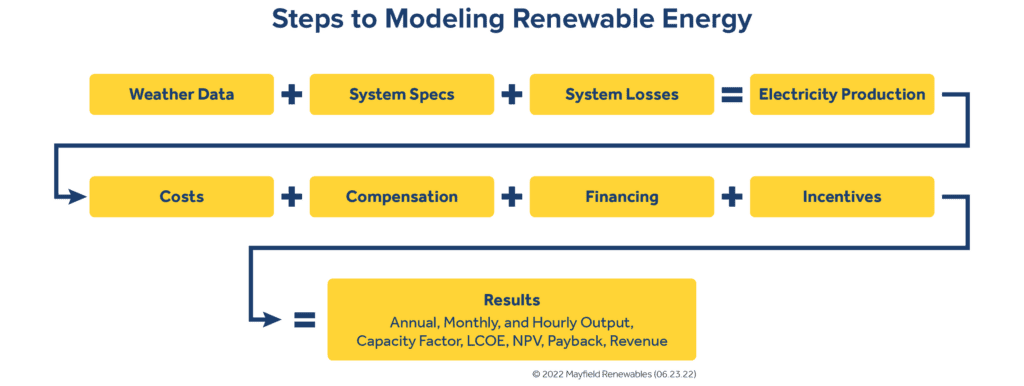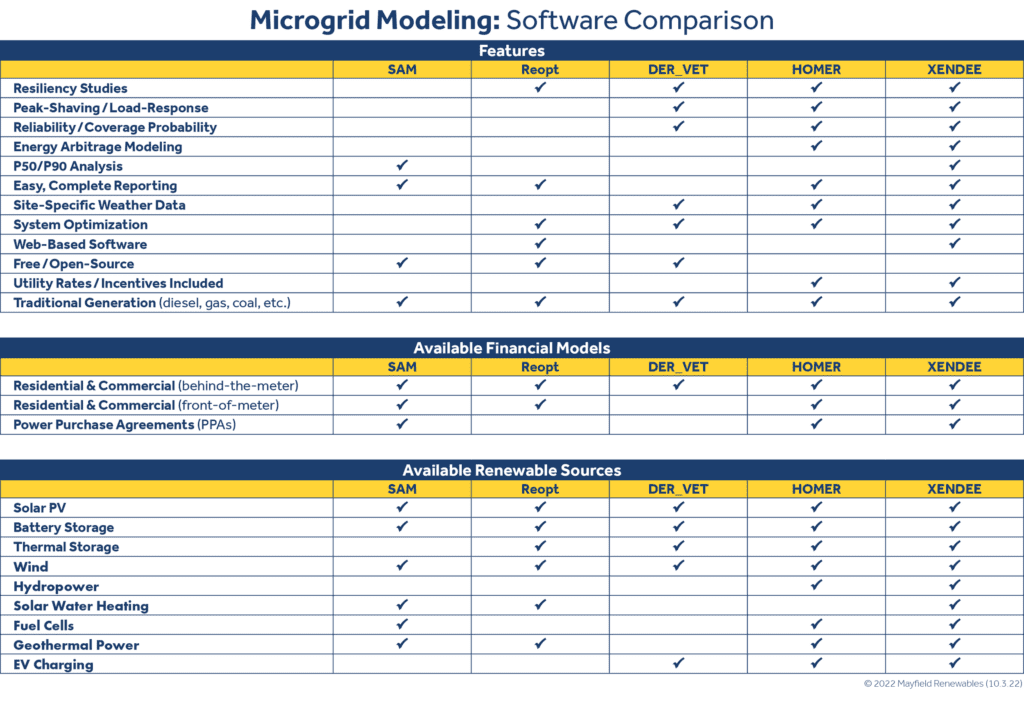Microgrids Part 3: Microgrid Modeling Software
The previous installment of our microgrids blog series discussed some of the pros and cons of microgrids, including real-world examples of beneficial (and profitable) microgrids already in place today. Residential buildings, large commercial stores, and even entire university campuses can see increased resiliency and reliability, all at a lower generating cost than traditional grid-tied rates. Many variables affect the overall results of the microgrid, starting with site-specific weather data and infrastructure, which will determine the total output potential. The estimated total output, local utility rates, and available incentives can help calculate the economic benefits. Finally, economic feasibility and other standards for the microgrid’s performance (load response, resiliency, energy arbitrage, etc.) can be used to calculate a more comprehensive picture of the microgrid’s potential benefits.
Many modeling tools are available to simulate the performance of a microgrid in a given location. They range from free online academic tools to paid downloads, and offer a variety of different features. In this part of Mayfield Microgrids, we will explore some of the most commonly used tools for modeling microgrids and overview the key features and benefits to look for in any microgrid modeling software. The modeling tools we will look at include the National Renewable Energy Laboratory (NREL’s) System Advisor Model (SAM) and REopt® platforms, the Electric Power Research Institute’s Distributed Energy Value Estimation Tool (DER-VET™), HOMER’s Pro/Grid programs, and XENDEE.

NREL System Advisor Model (SAM)
SAM is a computer model that calculates performance and financial metrics for renewable energy projects. Project developers, policymakers, equipment manufacturers, and researchers can use SAM’s easy-to-interpret graphs and tables to analyze different options for renewable energy projects quickly. SAM simulates the performance of various renewable generation and energy storage technologies, including a generic model for comparison with conventional systems. SAM’s simulation tools facilitate parametric and sensitivity analyses, weather variability studies (P50/P90). SAM also includes a full-featured, built-in scripting language called LK that automates simulations for batch processing and more complex analyses. Several macros come with SAM to help with tasks such as checking weather files, sizing PV systems, and other tasks.
NREL REopt®
The REopt® platform is used by NREL researchers to optimize energy systems for buildings, campuses, communities, microgrids, and more. REopt recommends the optimal mix of renewable energy, conventional generation, and energy storage technologies to meet cost savings, resilience, emissions reductions, and energy performance goals. The REopt® platform offers a range of features and capabilities to help commercial, government, and individual users with planning and optimizing renewable energy and energy storage systems. The REopt® web tool allows users to evaluate the economic viability of distributed renewable energy resources, identify system sizes and dispatch strategies to minimize energy costs, and even estimate how long a system can sustain critical load during a grid outage. The model allows the user to choose between different energy goals (cost savings, resilience, and clean energy) or drivers for the project and displays the results in an easy-to-read table with both performance and financial outputs. Financial models include local incentives but are only available for traditional buying/selling of power.
DER-VET™
DER-VET provides a free, publicly accessible, open-source platform for calculating, understanding, and optimizing the value of distributed energy resources (DER) based on their technical merits and constraints. The platform supports site-specific assessments of energy storage and additional DER technologies—including solar, wind, demand response, EV charging, internal combustion engines, and combined heat and power—in different configurations, such as microgrids. Customers, developers, utilities, and regulators across the industry can apply this tool to inform project-level decisions based on sound technical understanding and unbiased cost-performance data. DER-VET also provides easy-to-interpret results, including design, dispatch, reliability, and financial analyses.
HOMER
The HOMER software offers two separate solutions for microgrid modeling, HOMER Pro and HOMER Grid. The Pro software was also developed at NREL, and has become the industry standard for optimizing all types of microgrids, from village power and island utilities to grid-connected campuses and military bases. HOMER combines simulation, optimization, and sensitivity analysis into one software product so engineering and economics can work side by side. Pro is designed specifically for off-grid power systems (which are often still called microgrids, even if they don’t fit the DOE definition) but can also be used for grid-tied systems if there is no need for peak shaving, tariffs, or incentives in the model. Grid is made for behind-the-meter systems with a need for peak shaving or complex tariffs and incentives but can also model infrequent, extended outages.
XENDEE
XENDEE attempts to remove the technical barriers for initial feasibility studies with their patented adaptive user interface. The simplified interface removes the complexities of microgrid design and guides users through the design process with built-in checklists and tools to allow rapid and seamless collaboration between customers, developers, financiers, and regulators, regardless of prior experience with microgrids. In addition, XENDEE’s autonomous generative design algorithms calculate millions of possibilities to find optimal investment and control strategies for the microgrid based on the desired outcomes. The only inputs required by XENDEE are the clients’ desired goals (e.g. least-cost, resilience, or CO2 emission reduction) and site and load constraints to generate an optimized microgrid for any site.
Key Software Features
Obviously, there are tons of options out there for microgrid modeling, more than just the ones mentioned above. So how can we differentiate the modeling tools and find the best one for your business? Several key features can be used to distinguish them from each other based on your business’s and your client’s needs:
Price – Price will always be something to keep in mind for your business, but it shouldn’t be the first or only thing you consider! While paid licenses like HOMER or XENDEE have more advanced user interfaces, others yield the same quality of results for free but may be less intuitive to use or contain fewer reporting features. The cost will vary greatly depending on the number of users in your organization, and a single license for your resident microgrid expert could more than pay for itself.
Modeling Capabilities – Several performance measures and reports can be used to define the feasibility of a microgrid, so you will need to make sure your software can handle the analyses that your clients are most interested in. Some of the available reports in the microgrid softwares mentioned above include system resiliency studies, energy arbitrage modeling, peak-shaving or load-response analyses, probability-of-exceedance analysis (P50/P90), and reliability/coverage probability reports. The reports generated by some programs are good enough to send straight to the client, but others will require you to take some tables/figures and create your own customer-facing report.
Utility Tariffs/Complex Rate Analysis – Presumably, the most important part of any microgrid modeling for your clients will be the economic analysis, including total system cost and potential savings after construction. Most modeling softwares have the ability to enter utility tariffs, rates, and incentives manually, but this information isn’t always readily available. The paid programs typically include this information in the software, making it much easier to accurately model the financial side of the microgrid, beyond just upfront system costs, especially for those with less experience with utility rules and regulations.
Ease of Use – Finally, ease of use could be the biggest priority to your business, especially if your team has limited experience/expertise with microgrids. Some programs focus more on the technical side and others more on the user experience, but at the end of the day, your team members need to be able to use it accurately and efficiently. While all the programs above offer user manuals and video tutorials, paid softwares often offer training sessions or one-on-one consultations to help you get the most out of the software. Microgrids are an up-and-coming technology, and more advanced training in microgrid modeling and design could help prepare your team for the future of renewables.

Software Comparison
If price is your main concern, especially if you are just starting out with microgrid services, NREL’s SAM and REopt, and EPRI’s DER-VET are free and open-source software with the confidence of NREL’s expertise behind them. The annual base fee for HOMER Grid is $4,000 (which can be used for traditional grid-tied renewable designs too), HOMER Pro is $1,500 annually, and then XENDEE is $299/month, and can also be used for traditional grid-tied renewable projects. Price may put off some users, especially those just starting off with microgrid design, but the paid programs also offer considerably more modeling and reporting capabilities than their free counterparts.
If pure modeling power is your priority, XENDEE is probably the software for you. As you can tell from the chart above, it includes the most reports of all the programs, followed closely by HOMER. Both programs have excellent tables and figures accompanying the available reports and can be easily given straight to the client or modified to meet your in-house specifications. Of all the free softwares reviewed, DER-VET offers the best reporting capabilities, with SAM and REopt being more specialized tools. A combination of free softwares could greatly increase your modeling abilities. Still, there is no easy method for transferring microgrid systems between platforms which would require additional time to build the same system across multiple tools.
If dollar signs are most important for your client, all the above softwares offer some option for manually entering utility rates/tariffs and local renewable or resiliency incentives, but these are not always easy to find and usually harder to understand if you don’t have any experience. Of the free softwares, only REopt includes a searchable utility database (energy and demand charges only), and the others leave it to the user to enter for each project. HOMER Grid and XENDEE include searchable utility rates and tariffs databases, with other incentive templates available for manual entry. Depending heavily on location and client, different incentives can have a huge impact on project feasibility, so it’s important to ensure that any incentives are included and modeled properly, whether or not they are pre-loaded into the software.
Finally, if you are most interested in the easiest way to start modeling microgrids, REopt is your go-to. The free programs may require some back-end programming to accurately model everything that HOMER and XENDEE come pre-programmed to handle, but the user interface for REopt is the most intuitive of all the platforms. Training is recommended for all HOMER users, and while XENDEE has designed the program so users with little design or engineering experience can still successfully model basic microgrids, the more advanced features definitely have a bit of a learning curve. Reporting back to clients is incredibly easy with both XENDEE and REopt, but if you want to maximize productivity with the least training, I think REopt is the answer for you.
Conclusion
As you can tell, there are plenty of options for modeling microgrids, both free and paid. The user interfaces and features vary greatly between the different platforms, but for most businesses it comes down to a combination of 4 factors: price, modeling capabilities, rates/tariffs/incentives, and ease of use. Beginning designers may find the paid softwares easier to get the hang of, but some of the less complicated microgrid designs and reports can be done just as effectively and efficiently with free software. Ultimately, all of these modeling software programs can elevate your business and help sell projects to current and future clients, and it will be up to you to decide between price and performance.
Our team of solar-plus-storage experts also offers many microgrid development services, including feasibility studies, component selection and sizing, and full permit set development. To learn more, contact us at design@mayfield.energy or fill out the project form linked here.










